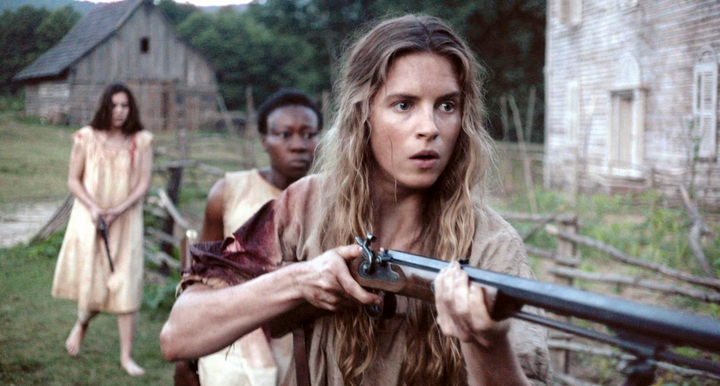
Julia Hart worked as a high school English teacher for eight years before she quit her job to create "The Keeping Room." It's rare for a screenwriter's first script to also be her first script to get produced, though, given Hart's revisionist ideas, it only makes sense her career path would mix things up.
"The Keeping Room" made its way to the big screen as a poetic, feminist Western, in which three women, left alone after the men left to fight the war, must defend their bodies and their home against Union soldiers.
Hart shows her strength as a writer by refusing to simply plop women in the place of the stalwart hero, opting instead to explore the complexity available in subverting the politics of the genre. In addition to the apparent resurgence of the Western, Hart adds women to the landscape who are strong not in spite of their vulnerability, but because of it.
In honor of the film's release this past Friday, The Huffington Post spoke to Hart about how she flipped the great American genre on its head and the key to creating nuanced female characters who are not just powerful but empowered.
What inspired you to write "The Keeping Room"?
I grew up watching Westerns. I love Westerns, but I definitely had this longing to see a strong woman walk through the swinging doors instead of a man.
I also heard a story that inspired it at a friend's family farm in Georgia. After we all had a little bit of moonshine, my friend starting telling me about the myth that came with the farm when they bought it, which was that there were two union soldiers buried out in the field. I thought that was so fascinating because they would have had to have been put there by the women who were left alone in the house at the time. So, that was where “The Keeping Room” started for me.
“I love Westerns, but I definitely had this longing to see a strong woman walk through the swinging doors instead of a man.”
There's definitely a masculinity inherent in the Western -- the ideas of ownership and power are crucial to the genre-- how did you reinvent that through a feminist lens?
You can’t just put a woman into a classic male role. You have to reinvent it so it is inherently female. I just thought about all of the classic tropes and cliches of the Western and tried to turn them upside down and make sure that they felt realistically feminine.
The women in the movie are emotional and emotionally connected and emotionally ravaged by the experience. It’s not that classic Western character who’s simply stoic and strong. They need the connection they have with each other. They need to break down and cry. You get all of those colors, that I think you maybe don’t always see classically in the genre.
That's important, I think, to see strong female characters who are also messy and complicated.
You know, in playing around with their resistance, I was thinking in terms of redemption and fear. When you are a woman alone and you are being attacked by a man who is physically more powerful than you and perhaps has more experience with these weapons, you would be afraid. And I think that a lot of the time because women are physically less strong or inexperienced in a way with violence, you have to use that fear to empower yourself.
Ah, that's interesting: fear as a tool.
Yeah, I think fear and empowerment are connected. You know, they use the adrenaline that causes in order to defend themselves.
Usually, when we see a “female action hero,” she’s a super-human-CGI-ed and tough, but it's not real. What I loved about these women is that they're real. The actors are doing everything you see on screen. There are no special effects. Brit [Marling] is really riding that horse, chopping that wood, loading and firing that gun. I think there’s something powerful about not an imaginary woman defending herself, but a woman actually doing it. It's almost shocking because we’re not used to seeing it.
“I was insistent that, no, none of the men can come in and rescue them.”
How do you feel about the idea of women being saved? Is it possible to have strong female characters be rescued by a man? You obviously avoided that in "The Keeping Room."
That was very important to me, and I had to defend that idea all the way through the shooting process. I was insistent that, no, none of the men can come in and rescue them.
For example, the character of Bill, who is Mad’s lover, comes back to try and save her. It was very important to me to me to show their love and that he would risk his life to come back for her, but also that he not be the one to rescue them. It felt so essential to the type of story I was telling that the women ultimately rescue themselves.
“You can be your messy, complicated self and that doesn’t mean you’re not a strong woman.”
Is that a rule you have for future films as well? I know you just wrote and directed a second film, "Miss Stevens."
For me, with other projects I’m working on, I’m looking at these classic genres and these classic tropes that have been dominated by men and turning them around and making them female. In the case of "The Keeping Room," it's a Western. I’m also working on a crime thriller. There’s a lot of stories about women that haven’t been told in these genres and there's a lot we can do there.
In flipping male-dominated genres on their heads, how do you define "strong" female characters?
I think the mistake that a lot of movies make -- and I don’t want to name any -- is just kind of dropping a woman into the role of the man. You know, inserting her as the stoic figure who has superhuman strength. I’m sure there are woman who are like that. But the truth of the matter is there are a lot of women who aren’t.
I think what’s so important about feminism is not just showing the “strong” impervious woman, but really showing that women are complicated and messy and emotional. You can be your messy, complicated self and that doesn’t mean you’re not a strong woman.
This interview has been edited and condensed.

